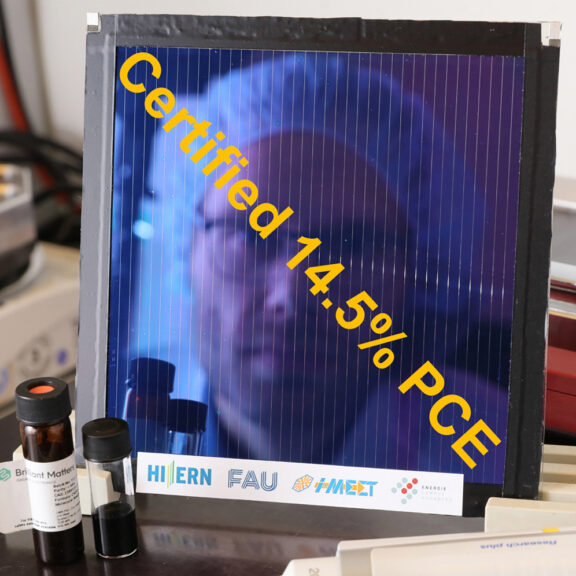Basu, R., Gumpert, F., Lohbreier, J., Morin, P.-O., Vohra, V., Liu, Y., Zhou, Y., Brabec, C.J., Egelhaaf, H.-J., Distler, A.
Joule 8, 1–9, April 17, 2024
Organic photovoltaics (OPVs) are a promising emerging PV technology with unique benefits, such as light weight, flexibility, transparency, tunable spectral absorbance, and a low-cost/-energy production process. With a power conversion efficiency (PCE) of close to 20% on small-cell level, OPVs are rapidly approaching the performance of conventional PV technologies. However, such high PCE values have not been able to be transferred to larger areas and the module level yet, which hinders the successful commercialization of the technology and impedes its entry into promising markets, such as building integration, aerospace applications, or agrivoltaics.
This work presents cutting-edge upscaling research on OPVs that aims at closing the efficiency gap between high-performance cells and modules. Utilizing computer simulations, the layout and manufacturing process of large-area OPV modules is optimized. Through this, a new certified world record efficiency for OPV modules of 14.5% is achieved and demonstrated.

Basu, R., Gumpert, F., Lohbreier, J., Morin, P.-O., Vohra, V., Liu, Y., Zhou, Y., Brabec, C.J., Egelhaaf, H.-J., Distler, A.
Joule 8, 1–9, April 17, 2024
Organic photovoltaics (OPVs) are a promising emerging PV technology with unique benefits, such as light weight, flexibility, transparency, tunable spectral absorbance, and a low-cost/-energy production process. With a power conversion efficiency (PCE) of close to 20% on small-cell level, OPVs are rapidly approaching the performance of conventional PV technologies. However, such high PCE values have not been able to be transferred to larger areas and the module level yet, which hinders the successful commercialization of the technology and impedes its entry into promising markets, such as building integration, aerospace applications, or agrivoltaics.
This work presents cutting-edge upscaling research on OPVs that aims at closing the efficiency gap between high-performance cells and modules. Utilizing computer simulations, the layout and manufacturing process of large-area OPV modules is optimized. Through this, a new certified world record efficiency for OPV modules of 14.5% is achieved and demonstrated.